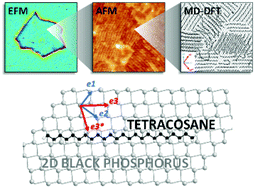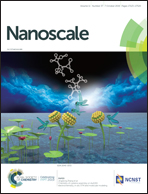Epitaxial multilayers of alkanes on two-dimensional black phosphorus as passivating and electrically insulating nanostructures†
Abstract
Mechanically exfoliated two-dimensional (2D) black phosphorus (bP) is epitaxially terminated by monolayers and multilayers of tetracosane, a linear alkane, to form a weakly interacting van der Waals heterostructure. Atomic force microscopy (AFM) and computational modelling show that epitaxial domains of alkane chains are ordered in parallel lamellae along the principal crystalline axis of bP, and this order is extended over a few layers above the interface. Epitaxial alkane multilayers delay the oxidation of 2D bP in air by 18 hours, in comparison to 1 hour for bare 2D bP, and act as an electrical insulator, as demonstrated using electrostatic force microscopy. The presented heterostructure is a technologically relevant insulator-semiconductor model system that can open the way to the use of 2D bP in micro- and nanoelectronic, optoelectronic and photonic applications.



 Please wait while we load your content...
Please wait while we load your content...